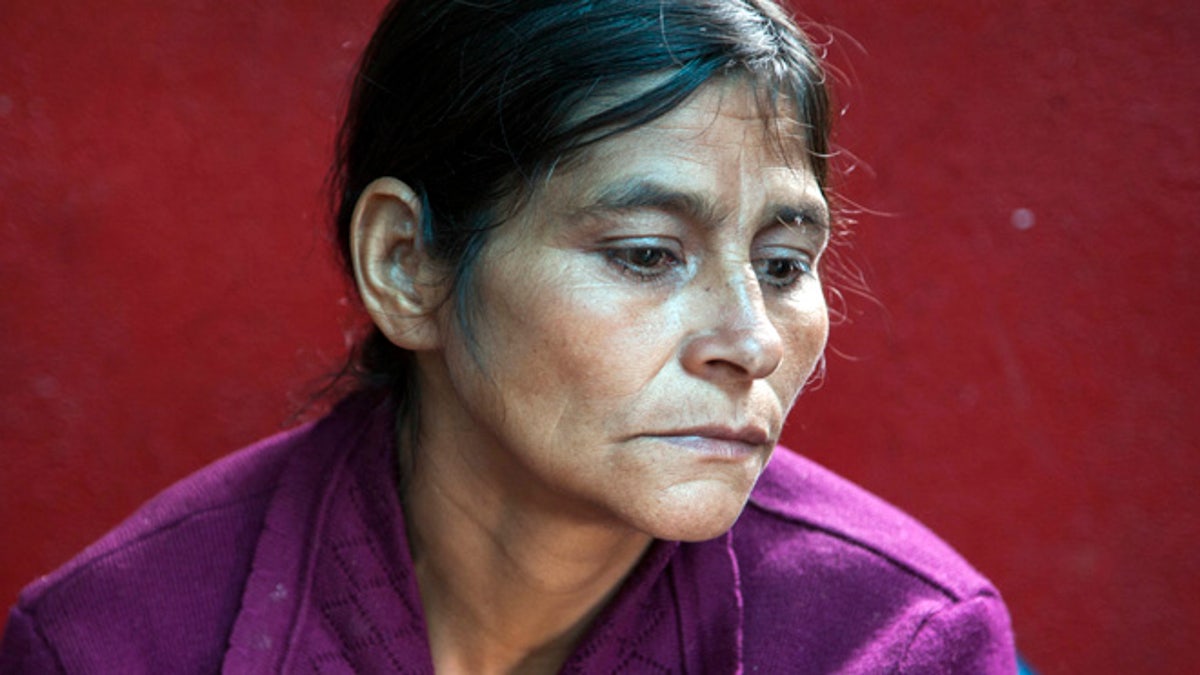
July 1, 2014: Cipriana Juarez Diaz, mother of Gilberto Francisco Ramos Juarez, a Guatemalan boy whose decomposed body was found in the Rio Grande Valley of South Texas, listens to her husband talk during an interview at their home in San Jose Las Flores, in the northern Cuchumatanes mountains of Guatemala. (AP)
SAN JOSE LAS FLORES, Guatemala – Gilberto Ramos wanted to leave his chilly mountain village for the United States to earn money to treat his mother's epilepsy.
His mother begged him not to go. "The better treatment would have been if he stayed," Cipriana Juarez Diaz said in a tearful interview with The Associated Press on Tuesday. When he wouldn't relent, she draped him with a white rosary for safe passage.
A month later, his decaying body was found in the Texas desert. Now, the boy has become a symbol for the perils faced by a record flood of unaccompanied children from Central America who are crossing illegally into the U.S.
Authorities said Monday that Gilberto was 11, making him one of the youngest known such children to die crossing the desert. He was shirtless, having likely suffered heat stroke, but still wearing the rosary.
"He was a good son," Juarez said. "May God give me the strength to endure."
It turned out Gilberto was 15. His parents explained Tuesday that they had taken several years to register his birth because of the remoteness of their village in Guatemala's northern mountains. When they did, they had forgotten his actual birth date, so they listed the same date as his younger brother.
Teenage boys with working ability have long been part of the stream of young men heading north from Central America, seeking to escape poverty and gang violence. But the number of unaccompanied immigrant children picked up along the U.S. border has been rising for three years.
Migrants tell of hearing that children traveling alone and parents traveling with young kids would be released by U.S. authorities and allowed to continue to their destination. Gilberto, too, had heard in Guatemala that if he got in, he would be allowed to stay, his family said.
He was born and grew up in San Jose Las Flores in a modest wood and sheet-metal home in the Cuchumatanes mountains of Huehuetenango province along the Mexico border. At 6,600 feet above sea level, the exuberant beauty of peaks and canyons are in stark contrast to the extreme poverty. There is no running or potable water and only a latrine. There is food, tortillas or wheat atole, an oatmeal-like drink, but never enough.
The cluster of homes where Gilberto lived is accessible only on foot along a rocky and often muddy mile-long path, which took 45 minutes in the canyons and mud to traverse on Tuesday. Gilberto walked that path each way to school, where he went as far as third grade before dropping out.
"He had to work to help the family," said his teacher, Francisco Hernandez, who remembered that Gilberto loved to draw.
Gilberto and his father, Francisco Ramos, hired themselves out to harvest and clean corn. Things improved when the oldest son, Esbin Ramos, reached Chicago and started working as a food preparer in a restaurant. He sends $100 to $120 a month when he can afford it, allowing the family to build a two-room home out of cement block to replace their wooden shack and paint it bright red and green. Gilberto slept on a piece of foam on the floor.
Short, quiet and humble, he stayed close to home. But he grew despairing and bored, Esbin Ramos said. Their mother grew sicker. The older brother suggested Gilberto come to Chicago, where he could return to school and work at night and on weekends.
Gilberto set out May 17 with a change of clothes and a backpack along the same path as his brother, walking the rugged road to the center of town and then hitching a ride to Chiantla to meet up with the smuggler, known as a coyote. He left his cowboy boots behind because he didn't want them to get ruined, his father said.
The trip cost $5,400, and the family had borrowed $2,600 of that, paying $2,000 the first week of the journey and another $600 the week before he died. They still owe the debt.
Esbin Ramos said Tuesday that he didn't know much about how Gilberto reached the Mexican border city of Reynosa. Esbin went the whole way in the back of a semitrailer. He said Gilberto told him he arrived by bus.
"I'm OK, just the deposit money," Gilberto told his father as he was about to cross into Texas.
Then Gilberto and the coyote disappeared. His parents tried to call the coyote. Four days passed, then five, then six. By the eighth day, Esbin Ramos was worried. He called the Guatemalan consulate in Houston and in Guatemala seeking help, he said.
Then he got a call from a woman McAllen, Texas, from what agency he doesn't know, telling him his brother was dead. They had found the body June 15, authorities said, and Esbin's phone number on the inside of Gilberto's belt buckle, a tactic many migrants use to hide information from drug traffickers who are looking to extort money from their families.
The Guatemalan consulate notified the family on Tuesday that Gilberto's body would be returned soon, whenever there is an available flight. His father is already preparing his grave site in the local cemetery.
His bedridden mother stumbled to her feet Tuesday to pray at the altar set up where he slept. There are no photos. They sent them to the U.S. to identify the body.
"The coyote told me that he was going to take him to a safe place and I believed him," Francisco Ramos said. "But that was the fate of my son."





















